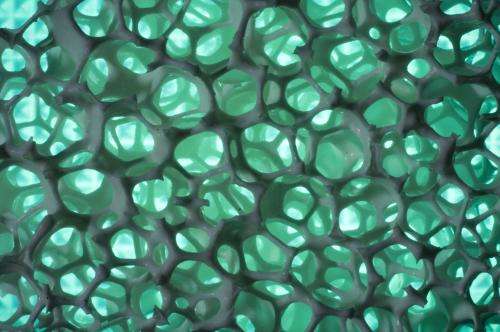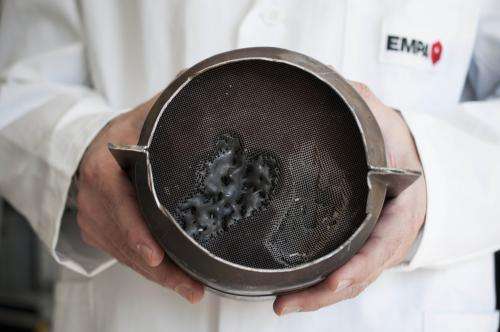Ceramic foam cleans up exhaust gases

The introduction next year of the Euro 6 exhaust-gas standard means that catalytic converters will become more expensive, above all for diesel vehicles. Empa is working on a catalytic substrate made of ceramic foam which, because of its structure, is more efficient and therefore more economic. Not only that—it also requires less noble metal coating.
Conventional catalytic cleaning units for exhaust gases are made with a regular honeycomb structure. The catalytically active layer, which contains valuable noble metals such as platinum, rhodium or palladium, is deposited on the surface of this one-piece, or monolithic, ceramic substrate. The hot exhaust gases flow through the catalyst in a non-turbulent manner. However, since most of the flow occurs in the middle of the catalyst, this region becomes exhausted more rapidly than the peripheral areas of the monolith, which remain more or less unused. In order to extend the service life of the unit, it must be made longer. But longer also means more surface area, more noble metal content and therefore higher cost.
Efficiency originating at Empa
Empa researchers from the Internal Combustion Engines Laboratory, under the leadership of Panayotis Dimopoulos Eggenschwiler, have succeeded in finding an innovative solution to this problem. The team is working on a catalytic substrate made of ceramic foam which, in future, will replace the conventional monolithic structure. For the same catalytic performance the novel device is significantly cheaper than the monolith-based unit. In contrast to the latter, the ceramic foam has in an irregular structure – much like a sponge – which causes the gas passing through it to flow in a turbulent manner, distributed equally throughout the whole of its volume. Although the foam catalyst actually has less surface area than the monolith, this area is much more efficiently utilized. As a result, to achieve the same effect as a conventional catalytic unit, the ceramic type requires only one third as much expensive noble metal – and only half the physical length.

Despite the fragility of the ceramic foam, with the help of colleagues from Empa's High-Performance Ceramics Laboratory the scientists succeeded in increasing the mechanical strength of the material many times over. Currently the research team is working to optimize the structure of the ceramic – the foam substrate has a greater air resistance than the monolith, which results in a slight comparative increase in fuel consumption. Using sophisticated computer simulation techniques, the Empa team has developed foam structures which reduce the air resistance without affecting the necessary turbulence.
Although at the moment the foam catalyst is being manufactured purely on the laboratory scale at Empa, industrial contacts are already showing interest in the new device. The Belgian material technologies company Umicore is a partner in the project, as is Fiat Powertrain Technologies. The foam catalyst is being proven in a diesel test vehicle on the Empa site. In addition, over the last 18 months a vehicle fitted with the innovative new catalyst belonging to the Industriellen Werke Basel (IWB) has been driven around in a long-term test eventually intended to cover at least 150,000 km.
Cheaper catalysts despite more stringent exhaust gas standards
The Foamcat represents the ideal alternative to the monolithic catalyst, above all for small diesel vehicles. After the Euro 6 exhaust-gas standard comes into force in September 2014, polluting emissions from diesel motors will be obliged to sink significantly. In particular, after this date a nitrogen monoxide catalyst will be compulsory. In combination with a particle filter and the conventional hydrocarbon and carbon dioxide catalyst, this will make exhaust gas treatment for diesel automobiles significantly more expensive. With its greatly reduced requirement of expensive noble metals, Empa's Foamcat will help to minimize these costs.




















